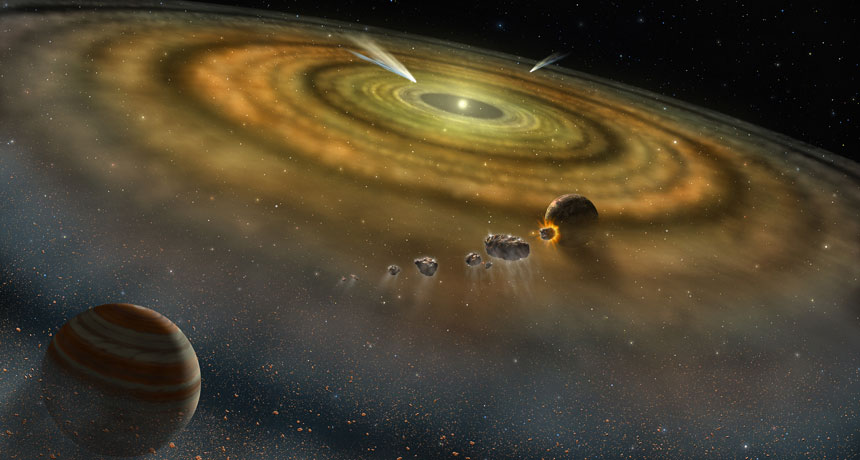What do you call a moon that escapes its planet? A ‘ploonet’
Giant planets in other star systems might lose their moons, creating new planets

Meet the ploonets. These are planets that used to be moons.
There are none of these planets in our solar system. But they might exist in other star systems. There, some moons might escape their parent planets’ gravity and start orbiting their parent stars instead. That’s according to new computer simulations. Scientists have dubbed the liberated worlds “ploonets.” And, the scientists say, current telescopes may be able to find the wayward objects.
The scientists’ thinking starts with these facts. There are planets that orbit other stars out in space. And those planets could have moons. Those moons are called exomoons. Exomoons should be common. But efforts to find them have turned up empty so far.
One person who wants to know more about these moons is Mario Sucerquia. He is an astrophysicist at the University of Antioquia in Medellín, Colombia. He and his colleagues used computer models to simulate what would happen to moons in other star systems. The team was particularly interested in moons that orbited hot Jupiters. These are giant gas planets that lie scorchingly close to their stars. They orbit their stars within days — sometimes just a few days make up their year.
Many astronomers think that hot Jupiters weren’t born so close to their stars, though. Instead, the planets moved toward their star from a more distant orbit. That movement messes with any moon the planet might have. What happens is the gravity — the tug between the planet and star — adds energy to the moon’s orbit. The moon then is pushed farther and farther from its planet. Eventually, it escapes its planet’s gravity.
“This process should happen in every planetary system composed of a giant planet in a very close-in orbit,” Sucerquia says. “So ploonets should be very frequent.” His team reported its analysis June 29 at arXiv.org.
Pinpointing ploonets
The team’s work shows that some ploonets may look the same as ordinary planets. Others, however, might give themselves away. A ploonet, in theory, should stay close to its parent planet. The ploonet’s gravitational tugs might disrupt the parent planet’s orbit. Those tugs could change the timing of when the planet crosses in front of the star. Crossing in front of a star is called a transit. Those deviations in the planet’s transit could be seen by telescopes in space. You could find them by combining new data from planet-hunting telescopes like NASA’s TESS and old data from the now-defunct Kepler, Sucerquia says.
When moons become planets, though, their ploonethood may be fairly short-lived. About half of the ploonets in the researchers’ simulations crashed into either their planet or star within about half a million years. And half of the remaining survivors crashed within a million years. A million years is short in cosmic time. And such short lives might make ploonets more difficult to spot.
Ploonets might help to explain some bizarre features of planets outside the solar system. For example, moon debris from such crashes could lead to giant ring systems around planets. That debris might even be what makes up the 37 rings that encircle exoplanet J1407b, the team says.
Or, the ploonet may look more like a comet. If the ploonet, when it was a moon, had an icy surface or an atmosphere and then escaped its planet and moved closer to its star, the star’s heat would evaporate the ice. That would give the ploonet a tail like a comet’s. If the ploonet starts to evaporate, it could grow a long, light-blocking tail. That tail might explain strangely flickering stars like Tabby’s star, Sucerquia says.
“Those structures [rings and flickers] have been discovered, have been observed,” Sucerquia says. “We just propose a natural mechanism to explain [them].”
While our solar system doesn’t have any hot Jupiters, ploonethood may be possible here, too. Earth’s moon is moving slowly away, at a rate of about 4 centimeters (1.6 inches) per year. When it eventually breaks free, “the moon is a potential ploonet,” Sucerquia says. Don’t worry, he notes, that won’t happen for about 5 billion years.
The study is a good first step for thinking about what would happen to exomoons in real planetary systems, says Natalie Hinkel. She is a planetary astrophysicist who works at the Southwest Research Institute in San Antonio, Texas, who was not involved in the new work. “Nobody’s looked at the problem quite like this,” she says.
Plus, ploonet is “a wonderful name,” Hinkel says. “Normally I sort of eye-roll at these made-up names. But this one is a keeper.”







